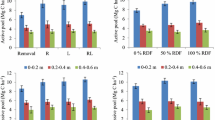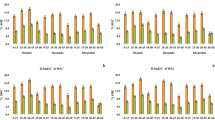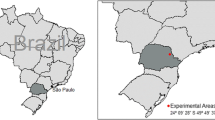Abstract
Soil organic carbon (C) and nitrogen (N) play a critical role in plant nutrient dynamics and crop yield performance under different soils. In this study, the amount of carbon (C), N and phosphorus (P) mineralization as influenced by type of organic residue and soil contact variation was studied for an incubation period of 75 days under controlled laboratory conditions. Different types of residues, viz. subabul residue (Leucaena leucocephala) (T1), biochar of subabul residue (T2) and FYM (T3), along with unamended soil with no residue constituted the three modes of application, viz. buried (t1), incorporated (t2) and surface applied (t3) treatments. Among all the treatments, subabul residue applied treatments showed highest rate of C mineralization in which surface applied (SA) treatments varied from 19.54 at 24 h to 239.55 mg CO2–C/100 g soil at 75 days followed by subabul incorporated (I) (17.04–237.8 mg CO2–C/100 g soil) and subabul buried (B) (15.91–225.5 mg CO2–C/100 g soil) treatments. Subabul incorporated (I) treatment showed lowest rate of mineralization of NO3–N, which varies from 0.010 and 0.613 mg kg−1 at 7 days to 4.640 and 10.03 mg kg−1 at 75 days after incubation followed by subabul buried (B) and SA treatments. These results will be useful in the selection of agriculture crop inputs and their proper placement in soils with respect to nutrient mineralization.


Similar content being viewed by others
References
Asai H, Samson BK, Stephan HM, Songyikhangsuthor K, Homma K, Kiyono Y, Inoue Y, Shiraiwa T, Horie T (2009) Biochar amendment techniques for upland rice production in Northern Laos 1. Soil physical properties, leaf SPAD and grain yield. Field Crops Res 111:81–84
Bailey VL, Fansler SJ, Smith JL, Bolton H (2011) Reconciling apparent variability in effects of biochar amendment on soil enzyme activities by assay optimization. Soil Biol Biochem 43:296–301
Baldi E, Toselli M (2014) Mineralization dynamics of different commercial organic fertilizers from agro-industry organic waste recycling: an incubation experiment. Plant Soil Environ 60:93–99
Beaton JD (1959) The influence of burning on the soil in the timber range area of Lac le Jeune BC II. Chemical properties. Canad J Soil Sci 39:6–11
Beaton JD, Peterson HB, Bauer N (1960) Some aspects of phosphate adsorption by charcoal. Soil Sci Soc Am J 24:340–346
Biederman LA, Harpole WS (2012) Biochar and its effects on plant productivity and nutrient cycling: a meta-analysis. Glob Change Biol Bioener 5(2):202–214
Borchard N, Ladd B, Eschemann S, Hegenberg D, Moseler BM, Amelung W (2014) Black carbon and soil properties at historical charcoal production sites in Germany. Geoderma 232–234:236–242
Bruun EW, Ambus P, Egsgaard H, Hauggaard-Nielsen H (2012) Effects of slow and fast pyrolysis biochar on soil C and N turnover dynamics. Soil Biol Biochem 46:73–79
Bruu EWMD, Müller-Stöver D, Ambus P, Hauggaard-Nielsen H (2011) Application of biochar to soil and N2O emissions: potential effects of blending fast pyrolysis biochar with anaerobically digested slurry. Eur J Soil Sci 62:581–589
Cantrell KB, Martin JH (2012) Stochastic state-space temperature regulation of biochar production. J Sci Food Agric 92:481–489
Castaldi S, Riondino M, Baronti S, Esposito FR, Marzaioli R, Rutigliano FA (2012) Impact of biochar application to a Mediterranean wheat crop on soil microbial activity and greenhouse gas fluxes. Chemosphere 85:1464–1471
Clough T, Condron L, Kammann C, Müller C (2013) A review of biochar and soil nitrogen dynamics. Agron 3:275–293
Clough TJ, Condron LM (2010) Biochar and the nitrogen cycle. J Environ Qual 39:1218–1223
Coppens F, Garnier P, De-Gryze S, Merckx R, Recous S (2006) Soil moisture, carbon and nitrogen dynamics following incorporation and surface application of labelled crop residues in soil columns. Euro J Soil Sci 57:894–905
DeLuca TH, Aplet GH (2007) Charcoal and carbon storage in forest soils of the Rocky Mountain West. Front Ecol Environ 6:1–7
DeLuca TH, MacKenzie MD, Gundale MJ (2009) Biochar effects on soil nutrient transformations. In: Lehmann J, Joseph S (eds) Biochar for environmental management. Earthscan, London, pp 251–270
Dempster DN, Gleeson DB, Solaiman ZM, Jones DL, Murphy DV (2012) Decreased soil microbial biomass and nitrogen mineralization with eucalyptus biochar addition to a course textured soil. Plant Soil 354:311–324
Dotaniya ML (2013) Impact of various crop residue management practices on nutrient uptake by rice-wheat cropping system. Curr Adv Agric Sci 5(2):269–271
Dotaniya ML, Datta SC (2014) Impact of bagasse and press mud on availability and fixation capacity of phosphorus in an Inceptisol of north India. Sugar Tech 16(1):109–112
Dotaniya ML, Datta SC, Biswas DR, Dotaniya CK, Meena BL, Rajendiran S, Regar KL, Lata M (2016) Use of sugarcane industrial byproducts for improving sugarcane productivity and soil health—a review. Intl J Recyc Org Waste Agric 5(3):185–194
Dotaniya ML, Datta SC, Biswas DR, Kumar K (2014) Effect of organic sources on phosphorus fractions and available phosphorus in Typic Haplustept. J Ind Soc Soil Sci 62(1):80–83
Dotaniya ML, Datta SC, Biswas DR, Meena HM, Kumar K (2014) Production of oxalic acid as influenced by the application of organic residue and its effect on phosphorus uptake by wheat (Triticum aestivum L.) in an Inceptisol of north India. Natl Acad Sci Lett 37(5):401–405
Dotaniya ML, Datta SC, Biswas DR, Meena HM, Rajendiran S, Meena AL (2015) Phosphorus dynamics mediated by bagasse, press mud and rice straw in inceptisol of north India. Agrochimica 59(4):358–369
Dotaniya ML, Rajendiran S, Meena BP, Meena AL, Meena BL, Jat RL, Saha JK (2016) Elevated carbon dioxide (CO2) and temperature vis- a-vis carbon sequestration potential of global terrestrial ecosystem. In: Bisht JK, Meena VS, Mishra PK, Pattanayak A (eds) Conservation agriculture: an approach to combat climate change in Indian Himalaya. Springer, New York, pp 225–256
Dotaniya ML, Rajendiran S, Meena VD, Saha JK, Coumar MV, Kundu S, Patra AK (2017) Influence of chromium contamination on carbon mineralization and enzymatic activities in Vertisol. Agric Res 6(1):91–96
Dotaniya ML, Sharma MM, Kumar K, Singh PP (2013) Impact of crop residue management on nutrient balance in rice-wheat cropping system in an Aquic hapludoll. The J Rural Agric Res 13(1):122–123
Elmer WH, Pignatello JJ (2011) Effect of biochar amendments on mycorrhizal associations and Fusarium crown and root rot of Asparagus in replant soils. Plant Dis 95:960–966
Farrell MKTK, Macdonald LM, Maddern TM, Murphy DV, Hall PA, Singh BP, Baumann K, Krull ES, Baldock JA (2013) Microbial utilisation of biochar-derived carbon. Sci Total Environ 465:288–297
Gaskin JW, Speir RA, Harris K, Das C, Lee DR, Morris LA, Fisher DS (2010) Effect of peanut hull and pine chip biochar on soil nutrients, corn nutrient status and yield. Agron J 102:1096–1106
Gomez KA, Gomez A (1983) Statistical procedures for agricultural research, 2nd edn. Wiley, New York
Gul S, Whalen JK (2016) Biochemical cycling of nitrogen and phosphorus in biochar amended soils. Soil Biol Biochem 103:1–15
Gundale MJ, DeLuca TH (2006) Temperature and source material influence ecological attributes of ponderosa pine and Douglas-fir charcoal. Forest Ecol Manage 231(1–3):86–93
Hammes K, Schmidt M (2009) Changes in biochar in soil. In: Lehmann J, Joseph S (eds) Biochar for environmental management. Earthscan, London, pp 169–182
Harvey OR, Li-Jung K, Andrew RZ, Patrick L, James EA, Bruce EH (2012) An index-based approach to assessing recalcitrance and soil carbon sequestration potential of engineered black carbons (biochars). Environ Sci Technol 46:1415–1421
Hernandez-Soriano MC, Kerre B, Goos P, Hardy B, Dufey J, Smolders E (2016) Long-term effect of biochar on the stabilization of recent carbon: soils with historical inputs of charcoal. Glob Change Biol Bioener 8:371–381
Hseu ZY, Jien SH, Chien WS, Liou RC (2014) Impacts of biochar on physical properties and erosion potential of a mudstone slope land soil. Sci World J. https://doi.org/10.1155/2014/602197
Huang M, Yang L, Qin H, Jiang L, Zou Y (2014) Fertilizer nitrogen uptake by rice increased by biochar application. Biol Fert Soils 50:997–1000
Jien SH, Wang CS (2013) Effects of biochar on soil properties and erosion potential in a highly weathered soil. CATENA 110:225–233
Jien SH, Wang CC, Lee CH, Lee TY (2015) Stabilization of organic matter by biochar application in compost amended soils with contrasting pH values and textures. Sustainability 7:13317–13333
Knoblauch C, Maarifat AA, Pfeiffer EM, Haefele SM (2012) Degradability of black carbon and its impact on trace gas flux and carbon turnover in paddy soils. Soil Biol Biochem 43:1768–1778
Lehmann J, Joseph S (2009) Biochar for environmental management: an introduction. In: Lehmann J, Joseph S (eds) Biochar for environmental management. Science and technology. Earthscan, London, pp 1–12
Lehmann J, Rillig MC, Thies J, Masiello CA, Hockaday WC, Crowley D (2011) Biochar effects on soil biota—a review. Soil Biol Biochem 43:1812–1836
Liang B, Lehmann J, Sohi SP, Thies JE, Neill BO, Trujillo L, Gaunt J, Soloman D, Grosmann J, Neves EJ, Liuzao FJ (2010) Black carbon affects the cycling of non-black carbon in soil. Org Geochem 41:206–213
Li L, Xiao-Zeng H, You MY, Yuan YR, Ding XL, Qiao YF (2013) Carbon and nitrogen mineralization patterns of two contrasting crop residues in a Mollisol: effects of residue type and placement in soils. Euro J Soil Biol 54:1–6
Manya JJ (2012) Pyrolysis for biochar purposes: a review to establish current knowledge gaps and research needs. Environ Sci Technol- 46:7939–7954
Maria CHS, Bart K, Peter MK, Benjamin H, Erik S (2016) Biochar affects carbon composition and stability in soil: a combined spectroscopy-microscopy study. Nat Sci Rep 6:1–13
Mukherjee A, Zimmerman AR (2013) Organic carbon and nutrient release from a range of laboratory-produced biochars and biochar–soil mixtures. Geoderma 193–194:122–130
Novak JM, Busscher WJ, Laird DL, Ahmenda M, Watts DW, Niandou MAS (2009) Impact of biochar amendment on soil fertility of a southeastern Coastal Plain soil. Soil Sci 174:105–112
Novak JM, Cantrell KB, Watts DW, Busscher WJ, Johnson MG (2014) Designing relevant biochars as soil amendments using lignocellulosic-based and manure-based feedstocks. J Soils Sed 14:330–343
Novara A, Gristina L, Rühl J, Pasta S, D’Angelo G, La Mantia T, Pereira P (2013) Grassland fire effect on soil organic carbon reservoirs in a semiarid environment. Solid Earth 4:381–385
Oliveira SP, Lacerda NB, Blum SC, Escobar MEO, Oliveira TS (2014) Organic carbon and nitrogen stocks in soils of northeastern Brazil converted to irrigated agriculture. Land Degrad Dev 26:9–21
Olsen SR, Cole CV, Watanabe FS, Dean LA (1954) Estimation of available phosphorus in soils by extraction with sodium bicarbonate. US Depart Agric Circ No 939
Paz-Ferreiro J, Fu S, Mendez A, Gasco G (2014) Interactive effects of biochar and the earthworm Pontoscolex corethrurus on plant productivity and soil enzyme activities. J Soils Sed 14:483–494
Sigua GC, Novak JM, Watts DW, Cantrell KB, Shumaker PD, Szogi AA, Johnson MG (2014) Carbon mineralization in two ultisols amended with different sources and particle sizes of pyrolyzed biochar. Chemosphere 103:313–321
Sigua GC, Novak JM, Watts DW, Szogi AA, Shumaker PD (2016) Impact of switch grass biochars with supplemental nitrogen on carbon–nitrogen mineralization in highly weathered Coastal Plain Ultisols. Chemosphere 145:135–141
Singh D, Chhonkar PK, Pandey RN (1999) Soil plant water analysis: a methods manual. Westville Publishing House, New Delhi
Song D, Xi X, Huang S, Liang G, Sun J, Zhou W (2016) Short-term responses of soil respiration and C-cycle enzyme activities to additions of biochar and urea in a calcareous soil. PLoSOne 11(9):e0161694
Spokas KA, Cantrell KB, Novak JM, Archer DA, Ippolito JA, Collins HP, Boateng AA, Lima IM, Lamb MC, Mc-Aloon AJ (2012) Biochar: a synthesis of its agronomic impact beyond carbon sequestration. J Environ Qual 41:973–989
Sui Y, Gao J, Liu C, Zhang W, Lan Y, Li S (2016) Interactive effects of straw-derived biochar and N fertilization on soil C storage and rice productivity in rice paddies of Northeast China. Sci Total Environ 544:203–210
Sun JN, He FH, Zhang ZH, Shao HB, Xu G (2016) Temperature and moisture responses to carbon mineralization in the biochar-amended saline soil. Sci Total Environ 569:390–394
Taghizadeh-Toosi A, Clough TJ, Condron LM, Sherlock RR, Anderson CR, Craigie RA (2011) Biochar incorporation into pasture soil suppresses in situ nitrous oxide emissions from ruminant urine patches. J Environ Qual 40:468–476
Takaya CA, Fletcher LA, Singh S, Anyikude KU, Ross AB (2016) Phosphate and ammonium sorption capacity of biochar and hydrochar from different wastes. Chemosphere 145:518–527
Tejada M, Benitez C (2014) Effects of crushed maize straw residues on soil biological properties and soil restoration. Land Degrad Dev 25:501–509
Vasu D (2015) Effect of biochar addition on soil carbon emission and nitrogen mineralization in some typical Indian soils. Intl J Emerg Res Manage Technol 4(11):17–22
Wang J, Sainju UM (2014) Soil carbon and nitrogen fractions and crop yields affected by residue placement and crop types. PLoSONE 9(8):1–11
Yao Y, Gao B, Zhang M, Inyang M, Zimmerman AR (2012) Effect of biochar amendment on sorption and leaching of nitrate, ammonium, and phosphate in a sandy soil. Chemosphere 89:1467–1471
Zheng H, Wang Z, Deng X, Herbert S, Xing B (2013) Impacts of adding biochar on nitrogen retention and bioavailability in agricultural soil. Geoderma 206:32–39
Zibilske LM, Bradford JM (2007) Oxygen effects on carbon, polyphenols, and nitrogen mineralization potential in soil. Soil Sci Soc Am J 71:133–139
Zimmerman AR (2010) Abiotic and microbial oxidation of laboratory-produced black carbon (Biochar). Environ Sci Technol 44:1295-130
Zibilski LM (1994) Carbon mineralization. In: Bingham JM, Mickelson SH (eds) Method of soil analysis, part 2. Microbiological and biochemical properties. SSSA book series no. 5. ASA, SSSA, Madison
Acknowledgements
The authors are highly thankful to the Director, HOD and technical staff of the Division of Soil Chemistry and Fertility, ICAR-IISS, Bhopal, as well as Director, ICAR-IIFSR, Modipuram, for necessary help during the course of the investigation. The authors are equally thankful to Dr B L Lakaria, Division of Soil Chemistry and Fertility, ICAR-IISS, Bhopal, for valuable help during the course of study.
Author information
Authors and Affiliations
Corresponding author
Additional information
Publisher's Note
Springer Nature remains neutral with regard to jurisdictional claims in published maps and institutional affiliations.
Rights and permissions
About this article
Cite this article
Meena, A.L., Jha, P., Dotaniya, M.L. et al. Carbon, Nitrogen and Phosphorus Mineralization as Influenced by Type of Organic Residues and Soil Contact Variation in Vertisol of Central India. Agric Res 9, 232–240 (2020). https://doi.org/10.1007/s40003-019-00425-7
Received:
Accepted:
Published:
Issue Date:
DOI: https://doi.org/10.1007/s40003-019-00425-7




